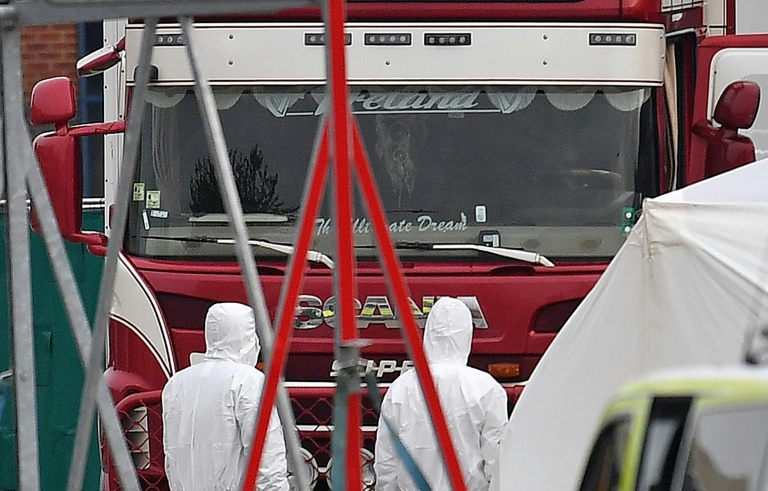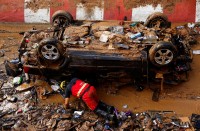
by Arman SOLDIN
Agence France Presse
GRAYS, United Kingdom (AFP) — Britain launched a major murder investigation after 39 dead bodies were found Wednesday in a refrigerated truck, once again putting the spotlight on the shadowy people trafficking business.
The corpses were found in a truck container at an industrial park in Grays, east of London, triggering outrage among politicians.
The local Essex Police force, which is working with immigration officials, said their initial priority was to try to identify the victims, thought at this stage to be 38 adults and one teenager.
The truck’s driver, a 25-year-old man from Northern Ireland, has been arrested on suspicion of murder and remained in custody through Wednesday, the force added.
“This is an unimaginable tragedy and truly heart-breaking,” Prime Minister Boris Johnson said.
He said the perpetrators of people smuggling, trading in human lives, “should be hunted down and brought to justice”.
Police were called to the scene at the Waterglade Industrial Park at around 1:40am (0040 GMT).
Officers in white forensic suits could be seen working by the truck and a white tent was erected outside through the day.
They later moved the vehicle to a “secure location” at nearby Tilbury docks, “so the bodies can be recovered whilst preserving the dignity of the victims,” deputy chief constable Pippa Mills told reporters.
“It’s absolutely imperative that the operation is conducted with the utmost respect for the 39 people who’ve lost their lives,” she said, adding “this will be a lengthy enquiry”.
– Tracing the route –
Police revealed that the vehicle’s storage trailer section had come by ferry from the Belgian port of Zeebrugge into Purfleet, close to Grays on the River Thames estuary — a crossing that takes nine to 12 hours.
Authorities in Belgium said they had launched their own probe.
Essex police added the ferry docked at 12:30 am (2330 GMT), and the truck then left the port area around half an hour later.
They said the “tractor unit of the lorry” — which drives the vehicle — is believed to have originated in Northern Ireland.
Meanwhile Bulgaria confirmed that the lorry had license plates issued by the country.
Prime Minister Boyko Borisov said it was registered there in 2017 by an Irish citizen, and had not entered Bulgarian territory since.
“There is no connection with us, just the licence plates,” he told national television.
Dimitar Dimitrov, executive director of the Bulgarian Chamber of Road Hauliers, told AFP many foreign hauliers registered in Bulgaria for financial reasons, and doubted whether a Bulgarian firm would employ Irish drivers.
Britain’s National Crime Agency said the number of migrants being smuggled into the UK in containers and trucks had risen in the last year.
In May the NCA said there had been “increasing use of higher risk methods of clandestine entry” to Britain by organised immigration crime gangs.
– ‘Evil’ contempt for life –
Jackie Doyle-Price, the MP representing the local Thurrock constituency, called people trafficking a “vile and dangerous business”.
“To put 39 people into a locked metal container shows a contempt for human life that is evil,” she said.
The gruesome discovery drew comparisons to previous cases.
In 2000, the bodies of 58 clandestine Chinese immigrants were discovered in a Dutch truck at the southeastern English port of Dover. Two people survived.
In 2014, around 34 Afghan Sikhs were found inside a shipping container at Tilbury port — next to Grays — suffering from severe dehydration, hypothermia and lack of air. One man was dead, having passed away during the sea crossing from Belgium.
In August 2015, at the peak of Europe’s migration crisis, the bodies of 71 migrants including a baby girl were found piled up in the back of a poultry refrigerator lorry left in Austria.
Investigations later revealed they had been transported along the Balkan migrant route and left to suffocate in the back of the truck after the driver dumped the vehicle near the Hungarian border.
© Agence France-Presse







